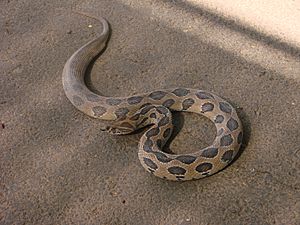Daboia facts for kids
Quick facts for kids Daboia |
|
|---|---|
 |
|
| A Russel Viper in Pune, India | |
| Scientific classification | |
| Kingdom: | |
| Phylum: | |
| Subphylum: | |
| Class: | |
| Order: | |
| Suborder: | |
| Family: | |
| Subfamily: | |
| Genus: |
Daboia
|
| Species: |
D. russelii
|
The Daboia is a type of venomous viper snake found in the Old World (meaning parts of Africa, Europe, and Asia). This group of snakes has only one main species called the Daboia russelii, which is better known as the Russell's Viper. It was named after Patrick Russell, a Scottish scientist who studied many Indian snakes a long time ago. The name "Daboia" comes from a Hindi word that means "that lies hid," which describes how these snakes often hide.
The Russell's Viper is one of the most dangerous snakes in India. Its bite is very serious and causes many snakebite incidents.
Contents
About the Russell's Viper
Russell's Vipers can grow quite long, sometimes up to 166 centimeters (about 5.5 feet). However, most of them are around 120 centimeters (about 4 feet) long. These snakes usually have a dark yellow or brown color. They are covered with many black spots, which helps them blend in with their surroundings.
Where Russell's Vipers Live
You can find the Russell's Viper in many countries across Asia. These include India, Pakistan, Sri Lanka, Bangladesh, Nepal, Myanmar, Thailand, Cambodia, and parts of China (like Guangxi and Guangdong). They also live in Taiwan and some Indonesian islands such as Endeh, Flores, east Java, Komodo, and Lomblen. Some people also believe they are found in Vietnam, Laos, and the Indonesian island of Sumatra.
Their Home
Russell's Vipers like to live in open areas with grass and bushes. They are also found in farmlands, flat coastal areas, plains, and hills. They prefer places where they can easily hide and hunt.
Different Names for the Russell's Viper
This snake has many different names depending on the language and region:
- In English, it's known as the "Russell's Viper," the "Chain Viper," the "Seven Pacer Snake," and the "Scissors Snake."
- In Urdu, Hindi, Hindustani, and Punjabi, it's called the "Daboia."
- In Oriya, it's known as the "Chandan Boda."
- In Kashmiri, it's called the "Gunas."
- In Sindhi, it's known as the "Koraile."
- In Bengali, it's called the "Bora" or the "Uloo Bora."
- In Gujarati, it's known as the "Chitalo" or the "Khadchitalo."
- In Marathi, it's called the "Ghonas."
- In Telugu, it's known as the "Katuka rekula paamu."
- In Thai, it's called the "Ngu maew sao."
- In Burmese, it's known as the "Mwe lewe."
- In Tamil, it's called the "Kannadi viriyan."
How Russell's Vipers Behave
Russell's Vipers live on the ground (they are terrestrial). They are usually nocturnal, meaning they are active at night. But if the weather is cool, they might be active during the day (diurnal).
When a Russell's Viper feels threatened, it raises its head and makes a loud hissing sound. This hiss is said to be louder than what other snakes make. When they bite, it can sometimes be a quick snap, or they might hold onto their target for a few seconds. Adult Russell's Vipers are often slow, but if you disturb them, they can become very aggressive. Because of their aggressive nature and strong venom, many animals and people are afraid of this snake.
Interestingly, another snake called the Rough-scaled Sand Boa has a similar color pattern to the Russell's Viper. This helps it look like the dangerous Russell's Viper, even though it is actually harmless! Adult Russell's Vipers have a lot of venom in their glands, usually between 21 and 268 milligrams. Young ones have less, about 8 to 79 milligrams.
What They Eat
The Russell's Viper eats a variety of things. Their diet includes rodents like rats, mice, and squirrels. They also eat land crabs, lizards, shrews, scorpions, and other small creatures with exoskeletons (arthropods). Young Russell's Vipers have even been known to eat each other, which is called cannibalism.
How Russell's Vipers Reproduce
Russell's Vipers are viviparous, which means they give birth to live young instead of laying eggs. They usually mate early in the year. A female snake is pregnant for about six months. She then gives birth to her babies between May and November, but most often in June or July.
A female Russell's Viper can give birth to many young at once, usually between 20 and 40 babies! When they are born, the young snakes are about 215 to 260 millimeters (around 8.5 to 10 inches) long. A Russell's Viper becomes an adult and can have its own babies after about 2 to 3 years.
Types of Russell's Vipers
Besides the main type found in India (called D. r. russelii), there is only one other known subspecies. This is the Eastern Russell's Viper (D. r. siamensis).
See also
 In Spanish: Daboia para niños
In Spanish: Daboia para niños

